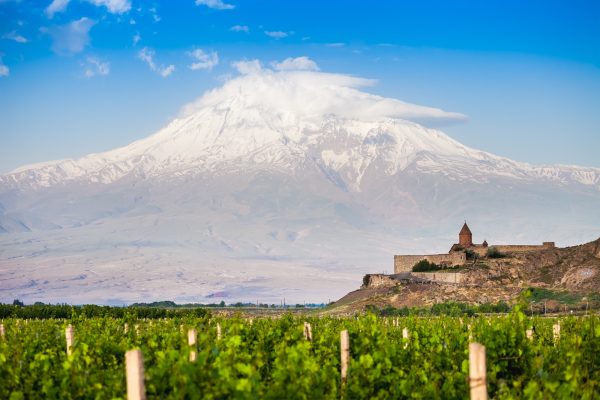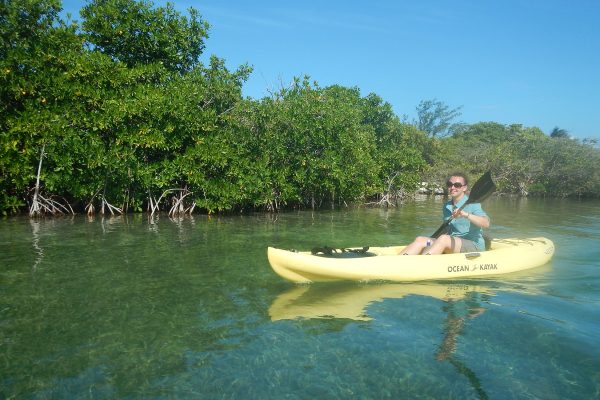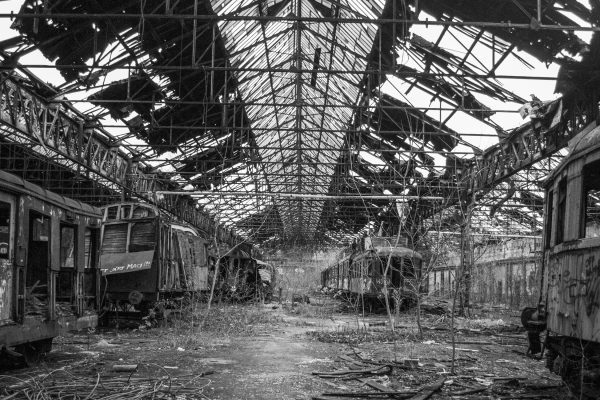Trip duration: 3 days | Approx cost: £500 | When: All year round
Doinit factor: You may well be the only tourist there!
etween the well-worn tourist destinations of Morocco and Tunisia lies Africa’s largest country, Algeria; and whilst it may be unmissable on any map of Africa it appears that most western tourists are blind to the prospect of a visit. It’s true the countries reputation doesn’t do it any favours but reputations have a tendency to unjustifiably linger on longer then they deserve. So with the capital city of Algiers being a little over two hours away I decided to step out of my comfort zone and discover for myself what we may be missing.
For a long weekend I can forget about exploring Algeria as a whole. I’ve seen images of the country’s endless deserts, striking mountains and enchanting oasis’s but this is a ‘city break’ so instead I’ll try to see if I can at least get a feel for Algiers. I’ve found very little in the way of any useful information in English online before my arrival. The only travel piece I came across is from an article in the Guardian back from 2012 asking, like me – why aren’t visitors coming here? Even as I board the aircraft I look around the cabin to see if I can spot anyone who may resemble a tourist; I don’t.
The Algiers of today was built by the French. Time hasn’t been kind to much of the city and the once pristine white facades are crumbling away. Arches and little balconies seem to defy gravity and appear to just about cling on to the walls they’re attached to. Through all this deterioration, yet quintessential French charm, there are signs of renovation and regeneration. The downtown boulevards are lined with well-kept trees providing a welcome shade, facades have been repaired and modern glass fronted shops, banks and Parisian style cafes now line the streets. Folks sipping on Arabic tea or enjoying a shawarma (in a French baguette) are oblivious to my presence – a stereotypical tourist with his big camera.


Above: Walking around downtown | Statue of Place Emir Abdel Kader
Wondering the streets my brother and I walk past the grand old post office, now closed but still probably the grandest post office I’ve seen on my travels. Not long after downtown our route begins to steepen, the relatively open spaces of the boulevards begin to close in; we are entering the Kasbah. Dating back to the 17th Century, the Kasbah is the ancient quarter of the city and a UNESCO world heritage site. It sits on a hill and is a labyrinth of narrow crooked alleyways criss-crossing each other. Local market sellers go about their business, the way they have done for centuries. It is hard work walking up steep steps but it’s definitely worthwhile if you want to feel like your back in time.


Above: We found the famous post office and continued our wander into the kasbah
Algeria is a massive city with a population of about three and half million so covering everything on foot can be exhausting, but fortunately Algiers has a pretty useful and modern Metro service. It’s been in development for over 30 years and for the time being, consists of the one line, but further stations are under constructions. It is a convenient way to travel and we’ll find ourselves on these trains on a couple of occasions as we travel around the city sights.
Cathédrale du Sacré-Cœur looks like a power station cooling tower. Its odd appearance is why I really fancy a visit. The entrance in a small court yard almost looking like a door to someone’s house, it’s locked so I hesitantly ring the bell. A few minutes a man emerges speaking in French. Not sure what he’s saying but he gestures us to come in and walk up the stairs to emerge in an amazing open space. The ceiling is a stunning blanket of concreate. The circular walls of the tower above us converse to a modest sky light about 50 meters above. The circular ceiling is supported by angled columns with narrow stain glass providing a stark contrast to the grey of concreate. It’s brutalist, it’s elegant, it’s surreal and I’m captivated by this structure. I certainly have a sense of solitude here, from the heat and from bustling streets outside.


Above: A visit to Cathédrale du Sacré-Cœur is well worth it
Throughout the city it is almost impossible not to notice the Martyrs’ Memorial. We opt to tackle the steep hill via a short cable car ride. Built on a hill overlooking large parts of the city, this 92 meter concrete structure consists of three twisted pillars joining part way with an internal flame beneath. It commemorates soldiers who died during the brutal Algerian war which lasted over seven years but led to the country’s independence. Far below the memorial are the Botanical Garden of Hamma (Botanical garden El-Hamma) which make for a pleasant walk despite the large crowds of locals enjoying their weekend.
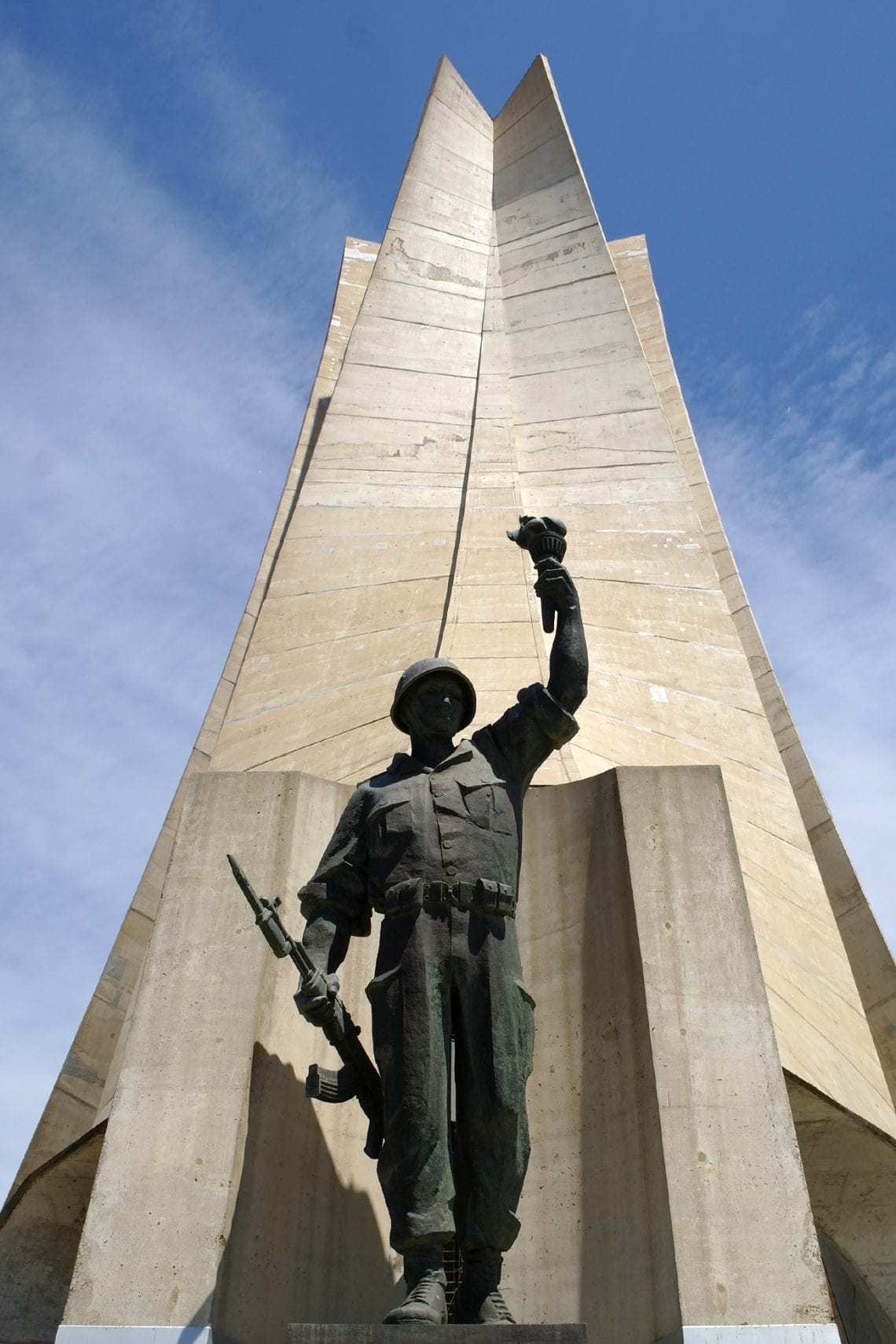
Above: You can’t miss the Martyrs’ Memorial overlooking Algiers
A day of walking around Algiers in the heat certainly builds up thirst and its time for a beer, but being in a Muslim country it may not be not be as straight forward as it sounds. However, where there is a will there is a way. Algiers is certainly more liberal and cosmopolitan then what I realised and there are a handful of restaurants which will happily serve you a refreshing (alcoholic) beverage. The trick to locating them appears to find a restaurant which you can’t see inside, has a locked door and a bell to ring. Valla, beer! That evening, almost by accident we seem to stumble upon a few pub like establishments where we can sample a few locally brewed beers (Namely, Tango). They are all packed full of elder gentleman smoking and drinking I also find it strange to that there aren’t any ladies toilets here – it’s clearly gents only.
Where to get a beer!
It’s not immediately obvious where you can get a beer but you defiantly can. Expect to pay between 300 -700 Dinar. I’ve put together a handy beer map of Algiers. Click here for beer!
About an hour (70km) from Algiers is the UNESCO world heritage site of Tipaza. After failing to find the appropriate bus station, we concede defeat and flag down a cab. It costs 2000 Dinar which is about £15. We arrive at Tipaza, the taxi driver doesn’t appear to know there are significant ruins here so after a bit of promoting he drops us by the sea front, outside a few restaurants. We walk past a quaint little harbour wall protecting little fishing boats bopping on the blue Mediterranean waters as we head towards the entrance to the archaeological park.
Just past the entrance we pass an ancient amphitheatre before taking a track towards the sea. Broken columns either side line our route with the stunning blue backdrop, making this a spectacular scene. With few visitors about, we’ve pretty much have this site all to ourselves. The surrounding landscape is also captivating, vegetation permanently wind swiped, green hills and mountains in the background, with rocky outcrops piecing the blue waters. It’s really peaceful, and feels like a world apart from Algiers which after a few hours we are bound for once again.
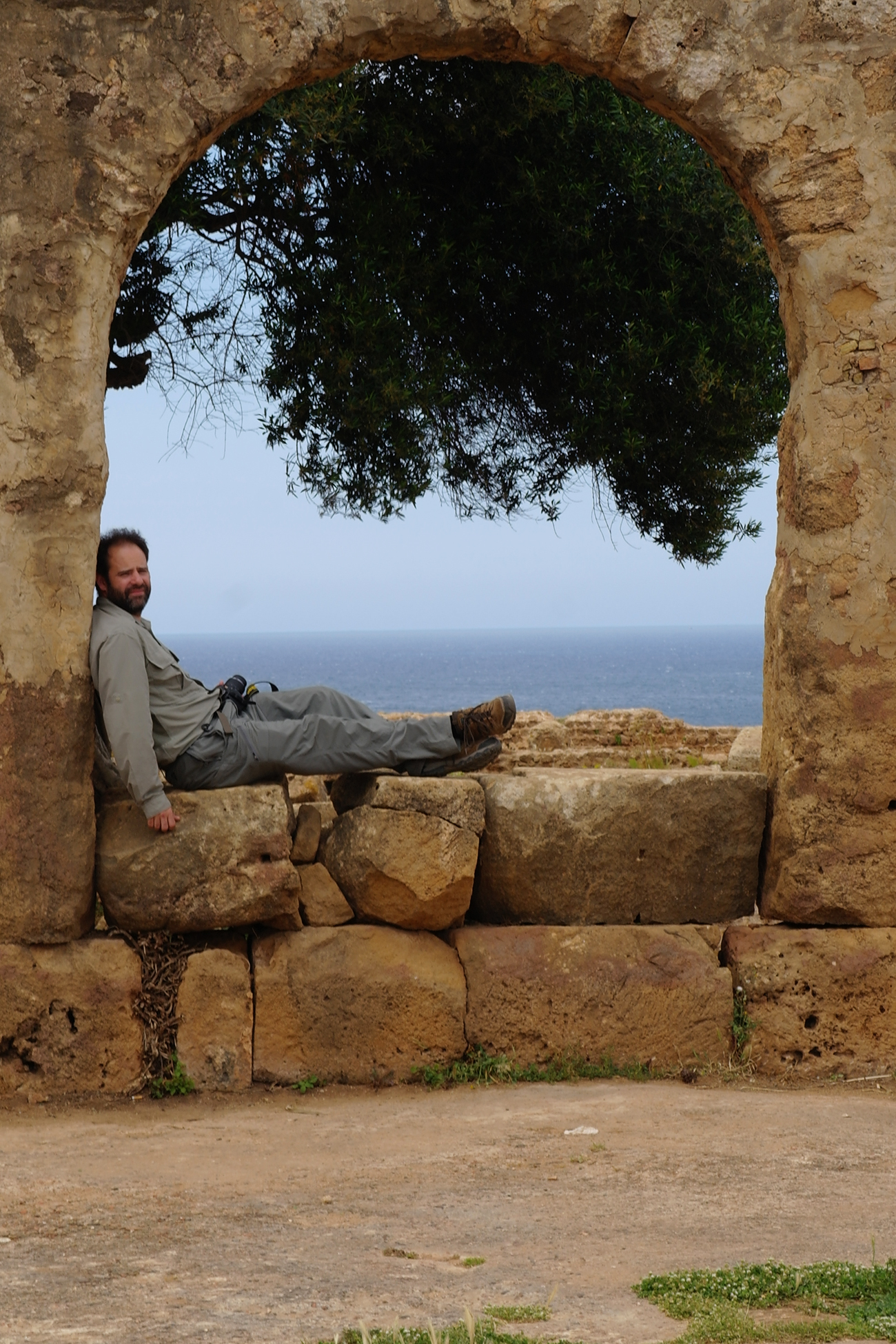

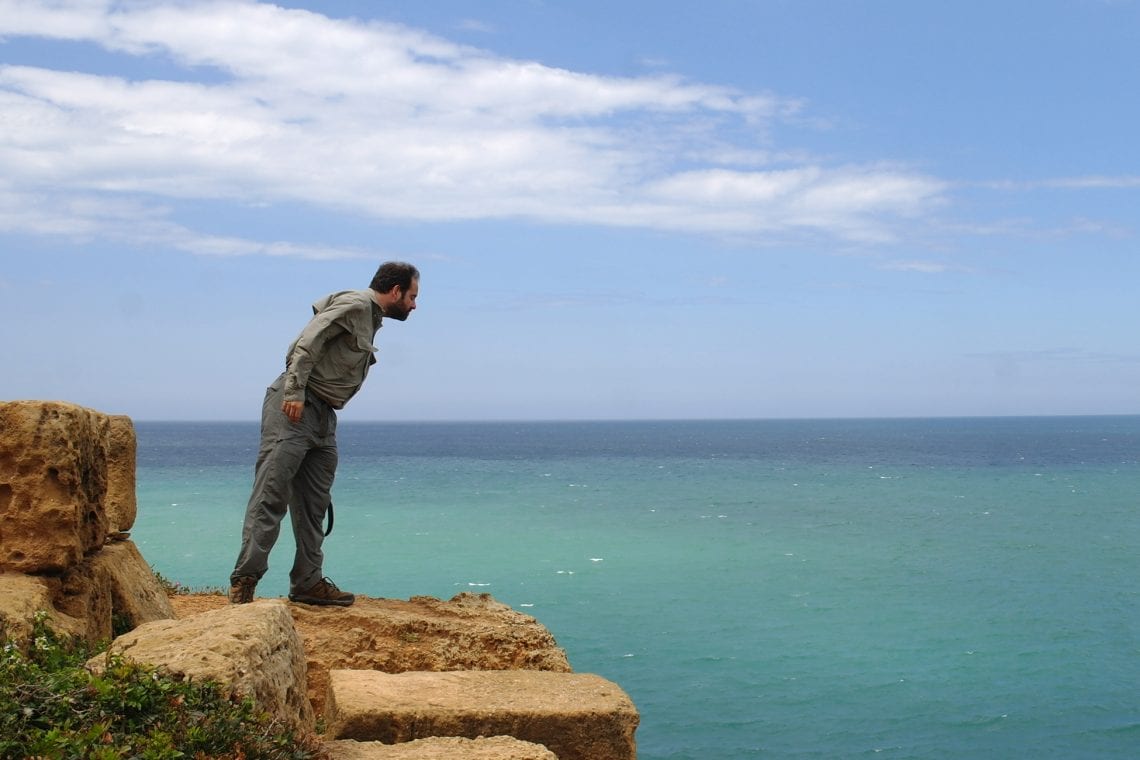
Above: Walking amongst the Roman ruins at Tipaza
On our return journey we ask our driver to drop us of at Algiers Notre Dame de Africa, a cathedral set on a hill above Eastern Algiers. It seems strange that our driver pulls over often asking pedestrians where this is. I’ve seen pictures, it’s huge, it’s on a hill, it’s visible for miles… Nether the less, he seems to struggle. Eventually just before sunset he gets us to where we want to be. This cathedral is beautiful. It’s taken 14 years to build and was finally completed in 1872. We arrive just in time for a sunset which is a real treat. It’s a fine end to the day before we once again go on search of Algiers illusive pubs.
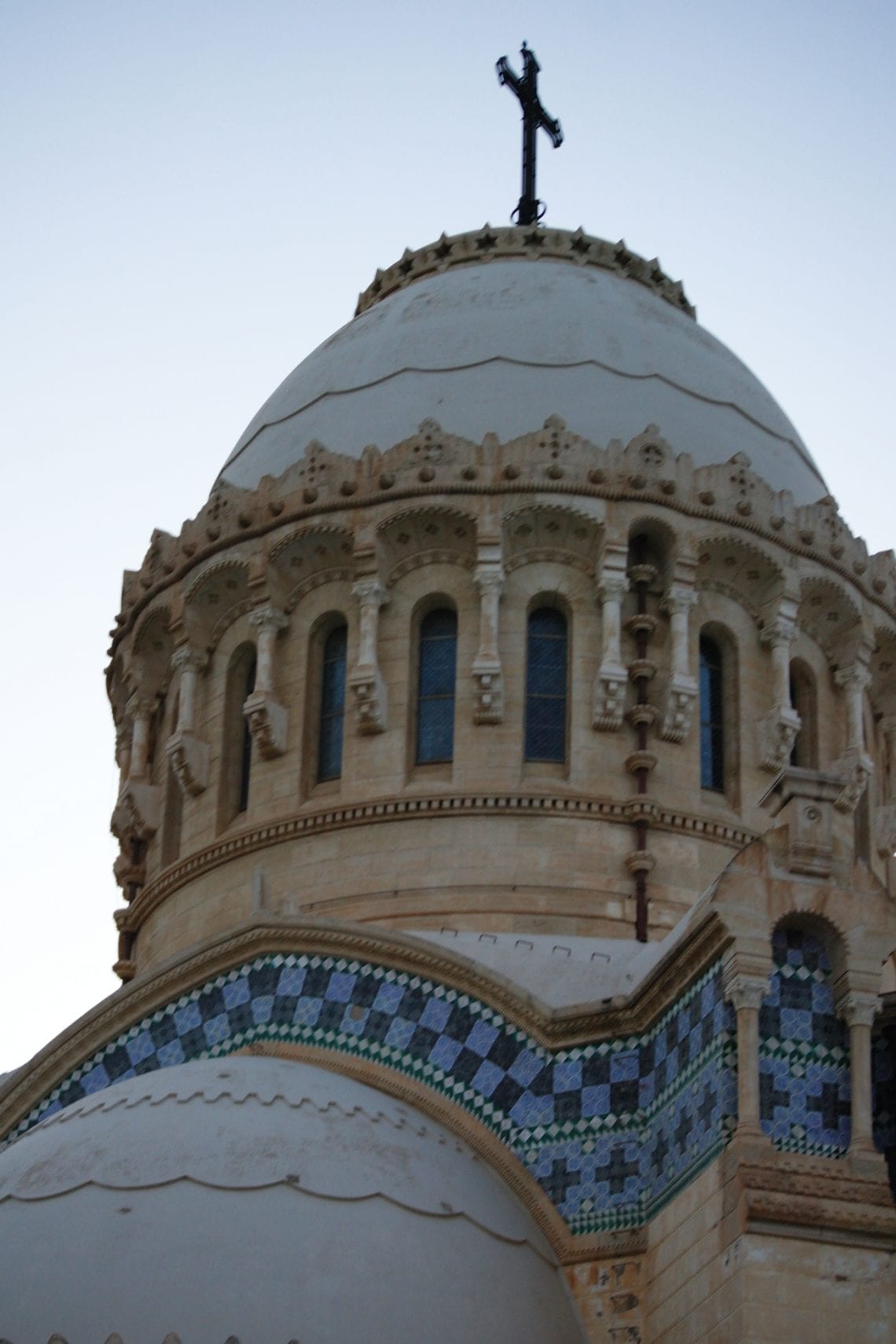
Above: Notre Dame de Africa overlooking Algiers at sunset
WHERE TO STAY
A simple internet search will relieve ample options for accommodation. Like all cities you can find luxury as well as more modest accommodation.
USEFUL LINKS
- You’re going to need a visa (straight forward) www.algerian-consulate.org.uk/visas/visa-to-algeria



